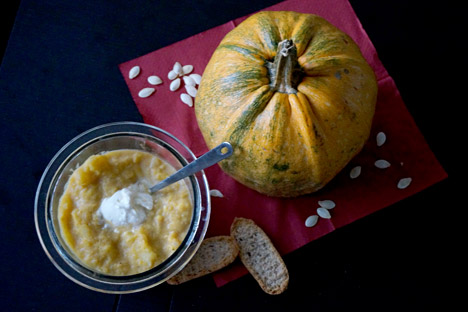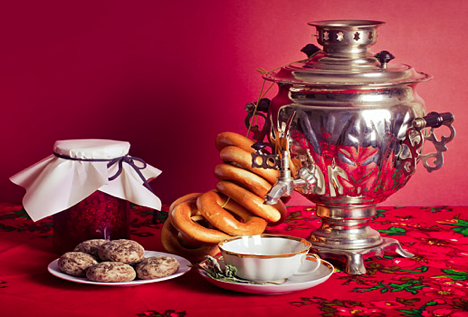Creamy Pumpkin Soup for the soul

Pumpkin Soup
Anna KharzeevaI love cream of pumpkin soup. I first tried it in a Moscow café when it became popular around six or seven years ago. The revelation that I actually like to eat pumpkins occurred to me when a friend shared her ‘rediscovering pumpkins’ experience with me. I started cooking the vegetable and was amazed to find just how versatile and delicious it is.
My initial dislike for pumpkins stemmed from the fact that I associated it mainly with porridge, which is how it was usually cooked during the Soviet era.
“Pumpkin soup isn’t a Russian thing. In Russia, pumpkin was usually steamed in the oven, sometimes with apples, and always served sweet. Millet porridge with pumpkin is a traditional Russian meal,” said Granny.
Although it is included in the Soviet Cook Book, it would appear that the recipe for creamed pumpkin soup did not make it to the masses, which is a shame.
One part of the pumpkin that was very popular was the seeds. Granny said there used to be women on every corner selling sunflower and pumpkin seeds by the glass.
Granny told me about an experience she had back in 1952. “After university I was sent to a village beside a bracket factory to teach maths at a local school. Students after university were allocated jobs in different parts of the country. All the teachers were fresh out of university from Moscow and Zagorsk [a town near Moscow now called Sergiev Posad]. As a class leader, I had to meet the family of every one of my students and work with them. The village itself was empty, though, and all the students came from villages nearby. When we arrived, we walked around new empty buildings, where we could choose any apartment we liked. We came into the room of the female construction workers. It was sparkling clean, but on the table there was a mountain of sunflower seeds — they would crack and eat them and throw the husks on to the shining clean floor.”
Snacking on seeds was a critical part of the very long chats typical of the Soviet era; these usually took place next to building entrances, which made it easier to discard the husks. This tradition has stood the test of time, and chatting while eating seeds remains a big part of Russian life.
After making my pumpkin soup, I dry the pumpkin seeds in the oven and snack on them. I must have got the habit from Granny, who has always been a big fan of pumpkin seeds.
Granny’s friend Galina Vassilyevna says in the village they would cut pumpkin into small pieces and roast it with some sugar as a snack for kids in between meals; healthy and tasty indeed!
Technological progress has now made blenders easily available, so we can finally give creamed pumpkin soup the recognition it deserves.
The pumpkin is not all porridge and seeds anymore!
Creamed Pumpkin Soup
 The recipe from the Soviet Cook Book, page 119
The recipe from the Soviet Cook Book, page 119
Ingredients
800 grams pumpkin; 150 grams croutons or 2 Tbsp flour; 300 grams potatoes; 4-5 cups milk; 3 Tbsp butter or oil; 2 Tsp sugar
There are two ways to prepare this soup:
1. Peel and wash the potato and pumpkin. Cut into this slices. Put in a soup pot. Add 3-4 cups water, salt, sugar and 1 tablespoon oil or butter and bring to a boil. Then simmer over low heat 25-30 minutes. In a saucepan, melt the remaining 2 tablespoons of oil or butter. Add croutons until they are soft and combined with the butter. Add to the pumpkin mix. Dilute with the hot milk and stir until thick.
2. Peel and wash the potato and pumpkin. Cut into this slices. Put in a soup pot. Add 2 cups of water and bring to a boil. In a separate saucepan, add 2 tablespoons oil or butter, melt and add the 2 tablespoons flour, 4 cups of hot milk and 2 cups of water. Boil and stir until mixture is smooth. Add to the pumpkin and cook 15-20 minutes. Then rub the soup through a sieve, add 1-2 cups hot milk, butter and mix well. Serve croutons separately.
All rights reserved by Rossiyskaya Gazeta.
Subscribe
to our newsletter!
Get the week's best stories straight to your inbox
